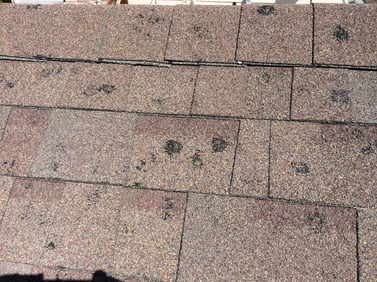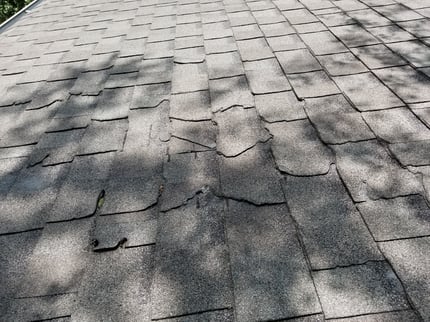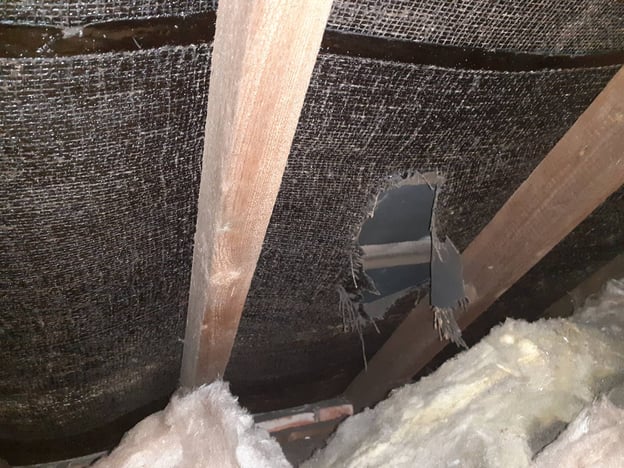When it comes to judging the value of a home, few people think of looking at the roof – but it...
15 Signs of Roof Damage and How to Spot Them
-1.jpg?width=5168&height=3448&name=phil-hearing-IYfp2Ixe9nM-unsplash-min%20(2)-1.jpg)
What Damages a Roof the Most?
Roofs can be damaged by a variety of factors, which can interact and exacerbate each other. For example, poor maintenance can make a roof more susceptible to weather damage, and water damage can be worsened by improper installation. Regular inspections and maintenance are crucial to prevent minor issues from becoming major problems. Here are a few:
1. Weather: Extreme weather conditions such as heavy rainfall, storms, and powerful winds can loosen, curl, or rip off shingles, leaving the roof deck underneath susceptible to water damage. Intense summer heat is also a culprit. It can cause roofing materials to expand and contract, leading to fading, crumbling, and detached shingles.2. Moisture: Water is the arch-enemy of roofs. Almost every sign of roof damage is a consequence of moisture buildup. Heavy downpours can wear down the protective layer of a roof and expose the shingles. If water penetrates the shingles, they can break down and expose the roof.
3. Poor roof maintenance: Improper roof maintenance can lead to costly consequences, such as water damage, mold growth, pest activity, and premature failure. Even the most durable materials can fall into disrepair without adequate maintenance.
4. Improper installation: A bad roofing job, leaving improperly attached shingles, inadequate sealing, or poor ventilation, can result in leaks, allowing water to seep through and cause problems. All these factors lead to the premature aging of roofing materials and leave your roof susceptible to repairs and even replacements.
5. Aging: Most roofing materials have a limited lifespan, and as they approach the end of that lifespan, they become more susceptible to damage and wear and tear. Asphalt roofs last about 20 years, and tile roofs, about 50. As your roof approaches these ages, you’ll want regular roof inspections to make sure that everything is working properly and rule out any need for premature replacements.
6. Pests: Rodents like squirrels, raccoons, and birds can nest on roofs and may enter your home through roof cracks and spaces, creating weak spots in your roof.

Squirrels damaging roofs. Source: Big Blue Bug.
7. UV radiation: UV radiation from sunlight leads to oxidative damage by altering and degrading the molecular composition of the materials safeguarding the shingle and the roof. Over time, this process leaves the underlying layers of the roof exposed.

UV damage on asphalt shingles. Source: Wikipedia
8. Physical damage: The impact of falling objects like trees and hail during harsh storms can also cause damage to the roof. Falling branches or trees can also result in debris building up in your gutter system. If you walk on the roof a lot, that can cause physical damage, too.

Damage from hail. Source: DIY Stack Exchange.
How to Spot Roof Damage
1. Leaky ceilings: One of the most obvious signs of roof damage is water stains on your ceilings. These stains may appear as discolored patches, bubbling paint, or even peeling wallpaper. Leaky ceilings indicate damaged or missing roof shingles, or a compromised roof structure.
Leaky ceilings. Source: Flickr.com
2. Missing or damaged shingles: Shingles protect the underlying structure of your roof, and their absence can lead to water infiltration, which can weaken your roof's integrity over time. After a heavy storm, closely examine your roof. If you notice any missing or damaged shingles, it's a clear indication of potential roof damage.

Damaged asphalt shingles. Source: Wikimedia Commons
3. Curling or buckling shingles: Curling or buckling shingles can be caused by exposure to extreme weather conditions or inadequate ventilation. These shingles are more likely to be blown off during a storm, exposing your roof to further damage. Keep an eye on shingles that appear warped or misshapen.

Curling asphalt shingles. Image source: Public Domain Pictures
5. Changes in shape: A roof misshapen in any form is a serious concern. Sagging and bowing may indicate structural damage, water retention, or rot. If you notice any areas of your roof appear sunken or sagging, you should seek professional assistance immediately to avoid further damage or a potential collapse.
6. Damaged flashing: Flashing is a vital component of your roof that seals joints and prevents water from seeping in. If the flashing is damaged or missing, it can create an entry point for water. Pay close attention to areas around vents, chimneys, and skylights, as these are common places where flashing is used.
7. Excessive moss or algae growth: While moss and algae may not damage your roof, they can hold moisture against the surface, leading to shingle decay and mold growth. Regularly cleaning your roof can help prevent this issue.
8. Daylight in the attic: Inspect your attic during the daytime. If you can see sunlight streaming through the roof boards, it's a clear sign of roof damage. This could result from damaged shingles, rotted wood, or gaps in the roof structure.
9. Higher energy bills: If your energy bills have been steadily increasing, it could be due to poor roof insulation or ventilation caused by roof damage. A damaged roof can affect your home's energy efficiency, leading to increased heating and cooling costs.
10. Broken or clogged gutters: When gutters are damaged or detached, it usually points to a broader issue with the roof's integrity, exposing more of the roof structure to the elements. Additionally, clogged or broken gutters can lead to water overflow, resulting in seepage under the roofing materials, leaks, and water damage.
11. Discoloration: This applies to all kinds of roofs, including metal roofing and shingle roofing. Discoloration on metal roofing can often indicate rust or corrosion, typically resulting from prolonged exposure to moisture or environmental pollutants. On shingle roofs, discoloration often signifies the growth of algae, mold, or mildew, which usually occurs in damp, shaded areas.
12. Musty smell: There is a distinct odor, often likened to the scent of wet socks or rotting wood, that arises from the presence of mold or mildew. These growths thrive in damp, poorly ventilated areas, which can pose health risks and indicate substantial roof damage.13. Ponding water: Commonly on commercial flat roof types, pools of water after rain indicate an increase in the load on the roof structure, leading to sagging or collapse. Prolonged water exposure can degrade roofing materials, promoting the growth of algae, mold, or mildew. In colder climates, the freeze-thaw cycle of ponding water can exacerbate cracks and splits in the roofing material.
14. Rot: Rot usually results from prolonged exposure to moisture, often due to leaks or poor ventilation. Look for telltale signs such as softened, discolored, or crumbling wood. In advanced stages, you might notice sagging or an uneven roofline. Inside the house, signs of rot can include discolored spots on ceilings, a musty odor, or visible mold growth.

Rot on a section of ridge beam | Image source: Reddit
15. Rips in membrane: Rips or tears in roofing membranes primarily affect flat or low-slope roofs that use these materials for waterproofing. These rips, which lead to all the consequences of water damage, can occur due to various reasons: physical damage from foot traffic or falling debris, structural movement of the building, or the membrane aging and becoming brittle over time.

Image Source: DIY Stack Exchange
What to Do if Your Roof is Damaged
If you notice signs of roof damage at your home or workplace, take the following steps to address the issue effectively:
- Document the damage: Take clear photographs of any visible signs of roof damage. This can be useful for insurance claims or for roofing professionals to assess the situation.
- Safety first: Avoid attempting to inspect or repair the roof yourself, especially if it involves climbing onto the roof. This can be dangerous and is best left to professionals.
- Temporary measures: If there's an immediate risk of water damage (like a leak), take temporary measures to protect the interior. This could include placing buckets under leaks or covering the affected area with a tarp.
- Contact Apex: Address roof damage promptly. Delaying repairs can lead to more extensive damage and higher repair costs. Reach out to Apex to conduct a thorough roofing inspection – this is completely free. Our professionals will assess the damage and let you know the extent of necessary repairs or if a replacement is needed.
- Review insurance policies: Check the home or business insurance policy to understand what types of roof damage are covered. Some policies may cover damage caused by certain events, like storms, falling objects or vandalism. Apex can help you with this.
Does Your Home or Workplace Have Roof Damage Signs?
Recognizing the signs of roof damage is crucial for maintaining the integrity and longevity of your home.
Regular inspections and maintenance can help identify issues before they become major problems. If you notice any of these signs or have concerns about your roof's condition, consult the professional roofing contractors at Apex. They will assess the damage and explain the necessary repairs or replacements.
By promptly addressing roof damage, you can protect your home and save money on costly repairs.
Book a free inspection with an Apex roofing specialist today.


-min.jpg?height=200&name=robin-kutesa-wmhhsI7GUQ8-unsplash%20(1)-min.jpg)
-min.jpg?height=200&name=908%20Vestlake%20Hollow%20Circle%2c%2035242-7%20(1)-min.jpg)